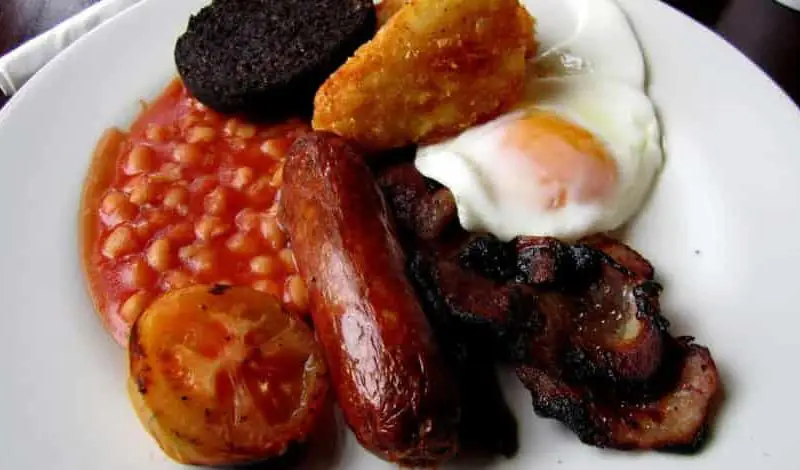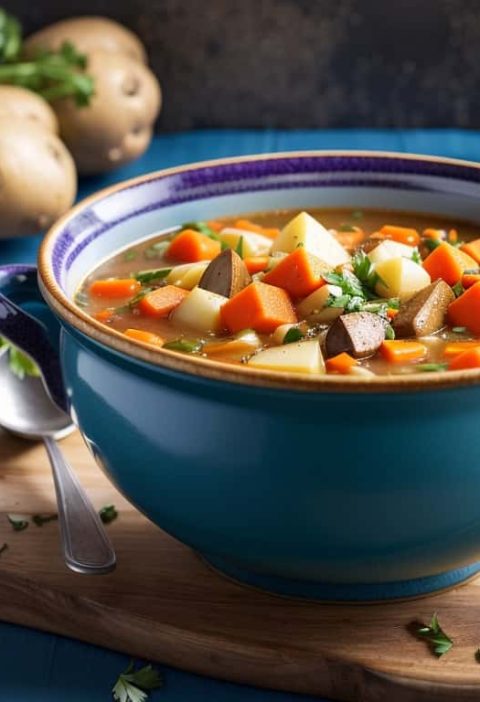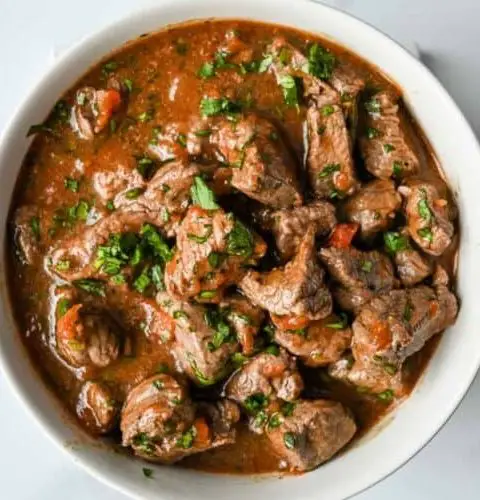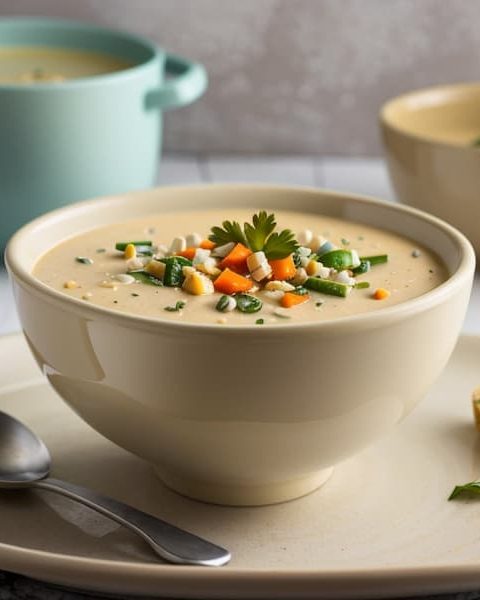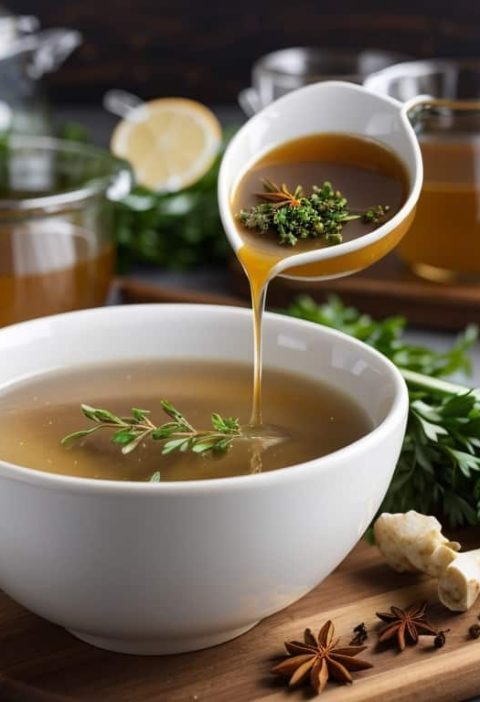Discovering foods from around the world isn’t just about enjoying new flavors. It’s a way to learn about different cultures through their food. Every type of food, from Italian pasta to Indian spices, tells a story about its people and their history.
How open are you to trying new foods?
Ever thought about why Italian pasta and Chinese noodles are so different?
Let’s explore these global cuisines together and find out what sets them apart.
British Cuisine
British cuisine, with its blend of traditional flavors and modern culinary techniques, offers a comforting and hearty dining experience. It’s characterized by its use of quality local produce, meats, and dairy. From classic roasts to innovative fusion dishes, British food balances rich history with contemporary innovation.
Must-Try Dishes
- Fish and Chips: A classic British dish featuring battered and fried fish served with chips, often accompanied by mushy peas and tartar sauce.
- Full English Breakfast: A hearty breakfast that typically includes eggs, sausage, bacon, beans, mushrooms, toast, and sometimes black pudding.
- Sunday Roast: A traditional British meal served on Sundays, featuring roasted meat (such as beef, chicken, or lamb), roast potatoes, Yorkshire pudding, vegetables, and gravy.
Cooking Tips
- Mastering a traditional Sunday roast involves perfecting the roast potatoes—crispy on the outside and fluffy on the inside—and making a rich, flavorful gravy from the meat juices.

Italian Cuisine: A Journey Through Taste
Italian cuisine, celebrated for its regional diversity and reliance on fresh ingredients, stands as a testament to the country’s rich cultural heritage. This cuisine’s uniqueness lies in its simplicity and the quality of ingredients rather than elaborate preparation.
Must-Try Dishes
- Pizza: Originating from Naples, this dish has become a global favorite, showcasing the simplicity of Italian flavors.
- Pasta: A staple of Italian cuisine, varying significantly in shape, size, and sauce pairings across regions.
- Risotto: A creamy rice dish that highlights the Italian mastery of turning simple ingredients into gourmet meals.
Cooking Tips
- A cornerstone of Italian cooking is the quality of ingredients—extra virgin olive oil, fresh tomatoes, basil, and garlic are essentials in the Italian pantry.
Chinese Cuisine: More Than Just Rice
The richness of Chinese cuisine lies in its vast regional varieties, from the spicy Szechuan to the subtle Cantonese styles. This diversity is a reflection of the country’s varied geography and climate.
Must-Try Dishes
- Peking Duck: A crispy delight from Beijing that’s both savory and aromatic.
- Dim Sum: An assortment of bite-sized treats hailing from the Cantonese tradition.
- Szechuan Chicken: Known for its bold spiciness and deep flavors.
Cooking Tips
- Mastering the art of stir-frying, central to many Chinese dishes, requires a good wok, high heat, and the right oil, such as peanut or sesame.
Indian Cuisine: A Spicy Spectrum
Indian cuisine is a vibrant assortment of flavors and dishes, with each region bringing its own unique taste and cooking style to the table. The use of a wide variety of spices is what gives Indian food its distinctiveness and depth.
Must-Try Dishes
- Butter Chicken: A creamy tomato-based dish that’s a staple in North Indian cuisine.
- Biryani: A fragrant, spiced rice dish beloved across the Indian subcontinent.
- Samosas: A popular snack filled with spiced potatoes, peas, and sometimes meat, perfect for any time of day.
Cooking Tips
- The key to Indian cooking lies in the balance of spices. Toasting them before grinding can unlock deeper flavors and aromas.
French Cuisine: The Art of Fine Dining
French cuisine is renowned for its culinary techniques and meticulous preparation, making it a cornerstone of gourmet dining worldwide. The emphasis on technique and the use of local ingredients exemplify the sophistication of French food.
Must-Try Dishes
- Coq au Vin: A slow-cooked chicken dish marinated in wine, embodying the depth of French culinary tradition.
- Bouillabaisse: A rich seafood stew that hails from Marseille, offering a taste of the Mediterranean.
- Macarons: Delicate meringue-based sweets that are as beautiful as they are delicious.
Cooking Tips
- Mastering the five mother sauces—béchamel, velouté, espagnole, sauce tomate, and hollandaise—is fundamental, as they form the base for many French dishes.
Japanese Cuisine
Japanese cuisine exemplifies the harmony between simplicity and the deep, savory flavor known as umami. It’s a culinary tradition that honors the natural taste of ingredients, often presented artfully.
Must-Try Dishes
- Sushi: A global favorite that combines vinegared rice with various toppings, primarily fish.
- Ramen: A noodle soup dish that has taken the world by storm, with rich broth and various toppings.
- Tempura: Lightly battered and fried seafood or vegetables, showcasing the delicate touch of Japanese cooking.
Cooking Tips
- Balancing flavors is key in Japanese cooking, with a focus on the subtle use of seasonings like soy sauce, mirin, and miso to enhance, not overpower, the natural flavors of the ingredients.
Spanish Cuisine
Spanish cuisine is a vibrant celebration of life, with meals often enjoyed in a communal setting. It’s characterized by its bold flavors and simple yet satisfying dishes that bring people together.
Must-Try Dishes
- Paella: A saffron-flavored rice dish mixed with various meats or seafood, embodying the heart of Spanish cooking.
- Gazpacho: A refreshing cold soup made from tomatoes, peppers, cucumbers, and onions, perfect for hot days.
- Tapas: Small plates of food shared among friends, ranging from olives and cheeses to more elaborate preparations.
Cooking Tips
- A well-stocked Spanish pantry includes olive oil, garlic, saffron, and paprika. These essentials can transform simple ingredients into flavorful dishes.
Thai Cuisine
Thai cuisine is renowned for its ability to balance the four fundamental taste senses: sweet, sour, bitter, and spicy. This cuisine offers an explosive tasting experience, with each dish designed to be a complex layering of flavors.
Must-Try Dishes
- Pad Thai: Stir-fried rice noodles with eggs, fish sauce, tamarind juice, and a combination of tofu, shrimp, or chicken, garnished with peanuts.
- Tom Yum Goong: A hot and sour soup with shrimp, embodying the essence of Thai flavor complexity.
- Green Curry: Made with green curry paste, coconut milk, and meat or vegetables, offering a spicy and sweet taste.
Cooking Tips
- Mastering Thai cuisine involves understanding how to make curry pastes from scratch. The balance of ingredients like lemongrass, galangal, and kaffir lime leaves is crucial.
Greek Cuisine: A Mediterranean Marvel
Greek cuisine is a testament to the Mediterranean diet, with a focus on freshness, simplicity, and the health benefits of olive oil. It combines the flavors of fresh produce, fish, and meats with the aromatic presence of herbs and spices.
Must-Try Dishes
- Moussaka: A layered dish of eggplant, minced meat, and béchamel sauce, baked to perfection.
- Souvlaki: Grilled skewers of meat, often served with pita bread, vegetables, and tzatziki sauce.
- Greek Salad: A refreshing mix of tomatoes, cucumbers, onions, olives, and feta cheese, dressed with olive oil.
Cooking Tips
- The use of high-quality olive oil and fresh herbs, like oregano and thyme, is central to Greek cooking, enhancing flavors naturally.
Mexican Cuisine
Mexican cuisine is as vibrant and colorful as its culture, with a wide array of flavors and ingredients that speak to the country’s rich history and diverse climates. It’s known for its varied sauces, beans, and corn-based dishes.
Must-Try Dishes
- Tacos: Perhaps the quintessential Mexican dish, tacos come in many varieties, with soft corn tortillas filled with meats, seafood, or vegetables.
- Mole: A complex sauce made with chili peppers, spices, and often chocolate, served over meat.
- Chiles en Nogada: A patriotic dish featuring poblano peppers stuffed with picadillo, topped with a walnut-based cream sauce and pomegranate seeds, representing the Mexican flag.
Cooking Tips
- Mexican cooking is known for its salsas, which range from the simple tomato-based salsa fresca to the more complex mole. Learning the basics of salsa preparation can add authentic flavor to any dish.
Turkish Cuisine
Turkish cuisine is a fascinating amalgamation of Central Asian, Middle Eastern, and Balkan flavors, reflecting the country’s rich history and geographic location. It offers a variety of dishes that are both flavorful and hearty, with a focus on meats, vegetables, and bread.
Must-Try Dishes
- Kebabs: A staple of Turkish cuisine, kebabs come in many forms, from skewered meats to the doner variety.
- Baklava: A sweet dessert made of layers of filo pastry, filled with chopped nuts and sweetened with syrup or honey.
- Meze: A selection of small dishes served as appetizers, including hummus, stuffed grape leaves, and more.
Cooking Tips
- Turkish bread making is an art form, with pide and simit being among the favorites. A hot oven and the right amount of kneading are key to achieving the perfect texture.
Moroccan Cuisine
Moroccan cuisine is renowned for its use of rich spices and unique cooking methods, such as the slow-cooked tagine. It combines sweet and savory flavors, offering a culinary experience that is both exotic and comforting.
Must-Try Dishes
- Tagine: A slow-cooked stew made in a traditional clay pot, combining meat with fruits and spices.
- Couscous: Steamed balls of semolina, usually served with vegetables and meat.
- Harira: A rich soup traditionally eaten during Ramadan, made with tomatoes, lentils, chickpeas, and meat.
Cooking Tips
- The art of using a tagine involves slow cooking over low heat, allowing the ingredients to tenderize and the flavors to meld beautifully.
Vietnamese Cuisine: Freshness First
Vietnamese cuisine stands out for its emphasis on fresh herbs and vegetables, creating dishes that are light yet flavorful. It’s a cuisine that balances sweet, salty, sour, and spicy with remarkable finesse.
Must-Try Dishes
- Pho: A fragrant noodle soup with a clear broth, served with herbs, lime, and chili.
- Banh Mi: A French-inspired sandwich filled with a variety of ingredients, including meats, vegetables, and condiments.
- Spring Rolls: Fresh or fried rolls filled with pork, shrimp, herbs, and vermicelli noodles, served with a dipping sauce.
Cooking Tips
- Balancing fish sauce and fresh herbs is essential in Vietnamese cooking. The fish sauce adds depth, while the herbs provide freshness.
Brazilian Cuisine
Brazilian cuisine is a diverse mix of flavors influenced by Portuguese, African, and indigenous peoples. It’s known for its hearty and robust dishes, often featuring beans, rice, and meats prepared in unique ways.
Must-Try Dishes
- Feijoada: Brazil’s national dish, a hearty stew of black beans with pork or beef, traditionally served with rice, collard greens, and orange slices.
- Acarajé: A street food made from black-eyed peas formed into balls and deep-fried in palm oil, served with spicy filling.
- Churrasco: A style of barbecue that includes various types of meat grilled over a fire, often served with farofa and vinaigrette sauce.
Cooking Tips
- The Brazilian way of meat grilling, or churrasco, requires high heat and simple seasoning, typically just coarse salt, to highlight the natural flavors of the meat.
Ethiopian Cuisine
Ethiopian cuisine is celebrated for its unique flavors and the tradition of communal eating, often from a shared platter, encouraging a sense of unity and family. The cuisine is known for its spicy stews and diverse vegetarian dishes, all scooped up with injera, a sourdough flatbread.
Must-Try Dishes
- Injera: A spongy, sour flatbread that serves as the base for most meals.
- Doro Wat: A spicy chicken stew, often considered Ethiopia’s national dish, rich in flavor.
- Tibs: Sauteed meat pieces, served hot and usually with vegetables and spices.
Cooking Tips
- Mastering Ethiopian cuisine involves learning the basics of spice blends like berbere and mitmita, which give dishes their characteristic heat and depth.
South Korean Cuisine
South Korean cuisine offers a harmonious blend of flavors and a deep respect for the tradition of fermentation, which is evident in staples like kimchi. Meals are usually accompanied by a variety of side dishes, known as banchan, that complement and contrast the main dishes beautifully.
Must-Try Dishes
- Kimchi: Fermented vegetables, usually cabbage, seasoned with chili peppers and garlic.
- Bibimbap: A mixed rice dish with vegetables, meat, a fried egg, and gochujang (chili paste).
- Bulgogi: Marinated beef grilled or stir-fried, known for its sweetness and smokiness.
Cooking Tips
- Essential Korean seasoning includes a balance of soy sauce, sesame oil, garlic, and sugar, along with gochujang for heat and complexity.
Lebanese Cuisine
Lebanese cuisine is a rich tapestry of flavors, reflecting the country’s long history and cultural diversity. It emphasizes freshness, with an abundance of fruits, vegetables, grains, and lean proteins, all enhanced by herbs and spices.
Must-Try Dishes
- Hummus: A smooth, creamy dip made from chickpeas and tahini.
- Tabouleh: A fresh herb salad with parsley, mint, bulgur, tomatoes, and lemon juice.
- Kebbeh: Considered Lebanon’s national dish, it’s made from ground meat, bulgur, and spices, often served fried or baked.
Cooking Tips
- Perfecting the art of mezze, an array of small dishes, requires attention to balance and variety, presenting flavors that complement each other.
Peruvian Cuisine
Peruvian cuisine is a vibrant fusion of indigenous, Spanish, and Asian influences, resulting in a unique and flavorful dining experience. It’s known for its innovative use of ingredients, including the many varieties of corn, potatoes, and chili peppers native to its land.
Must-Try Dishes
- Ceviche: Raw fish cured in citrus juices, spiced with chili peppers.
- Lomo Saltado: A stir-fry dish that combines marinated strips of sirloin with onions, tomatoes, and French fries, served with rice.
- Aji de Gallina: A creamy chicken stew made with aji amarillo (yellow chili pepper), nuts, and cheese.
Cooking Tips
- The key to perfect ceviche lies in the freshness of the fish and the balance of lime juice, chili, and seasoning to cure the fish without overpowering its delicate flavor.
Swedish Cuisine
Swedish cuisine encapsulates the simplicity and comfort of Nordic cooking, emphasizing seasonal and locally sourced ingredients. It’s known for its balance of sweet and savory flavors, often presented in dishes that bring warmth and comfort.
Must-Try Dishes
- Swedish Meatballs: Small, flavorful meatballs served with gravy, lingonberry jam, and mashed potatoes.
- Smörgåsbord: A traditional buffet-style meal featuring a variety of cold and hot dishes.
- Jansson’s Temptation: A creamy potato casserole with onions, pickled sprats, and cream.
Cooking Tips
- The tradition of fika, a coffee break that often includes pastries or sandwiches, is central to Swedish culture. Perfecting Swedish baked goods like cinnamon buns can add an authentic touch to your fika.
Russian Cuisine
Russian cuisine offers a hearty welcome through dishes that reflect the country’s vast geography and climate. It’s characterized by robust flavors and dishes that provide warmth and sustenance, often utilizing simple ingredients to create deeply satisfying meals.
Must-Try Dishes
- Borsch: A beet soup that combines meat and vegetables, served with sour cream.
- Pelmeni: Dumplings filled with meat, wrapped in a thin, unleavened dough, boiled, and served with butter or sour cream.
- Blini: Thin pancakes are often served with sour cream, jam, honey, or caviar.
Cooking Tips
- The secret to a perfect borsch lies in the balance of sweetness from the beets and acidity from a touch of vinegar or lemon juice, creating a richly flavored broth.
Australian Cuisine
Australian cuisine is a reflection of the country’s multicultural fabric, incorporating indigenous ingredients and the diverse culinary traditions of its immigrant population. It’s a cuisine that’s as varied as its landscape, offering a unique blend of flavors.
Must-Try Dishes
- Vegemite on Toast: A quintessential Australian breakfast, Vegemite is a savory spread made from yeast extract, enjoyed on buttered toast.
- Meat Pie: A hand-sized pie filled with minced meat and gravy, often consumed as a snack at sporting events.
- Barramundi: A type of seabass that’s popular in Australia, often grilled and served with lemon butter or herb sauces.
Cooking Tips
- Embracing native Australian ingredients like bush tomatoes, wattleseed, and lemon myrtle can elevate your cooking, adding unique flavors that reflect the country’s culinary heritage.
FAQs
What Are Classic British Cuisine Dishes?
Classic dishes of British cuisine include Fish and Chips, known for its crispy battered fish and golden fries; Full English Breakfast, a hearty meal featuring eggs, sausage, bacon, beans, mushrooms, and toast; and Sunday Roast, a traditional meal served with roasted meat, potatoes, Yorkshire pudding, vegetables, and gravy. These dishes are staples in British homes and pubs, showcasing the comfort and simplicity at the heart of British cooking.
What Are the Must-Try Dishes in Ethiopian Cuisine?
Ethiopian cuisine offers a variety of dishes rich in flavors and spices. Key dishes include Injera, a spongy sourdough flatbread that serves as a staple for most meals; Doro Wat, a spicy chicken stew considered Ethiopia’s national dish; and Tibs, sautéed meat pieces usually served with vegetables and spices. These dishes are central to the Ethiopian dining experience, emphasizing communal eating and a blend of unique spices.
How Do I Make a Perfect Borsch?
To make a perfect Borsch, start with fresh beets, cabbage, potatoes, carrots, onions, and garlic. Sauté the vegetables except for the beets, which you should boil separately to retain their vibrant color. Combine all ingredients in a large pot with beef or vegetable broth and simmer until tender. Add a touch of vinegar or lemon juice for a slight acidity and serve with a dollop of sour cream and fresh dill.
What Ingredients Are Essential in a Spanish Pantry?
A well-stocked Spanish pantry includes olive oil, garlic, saffron, paprika (both sweet and smoked varieties), sherry vinegar, canned tomatoes, beans, and rice. These staples are the foundation of many Spanish dishes, from Paella to Gazpacho, and help create the bold flavors Spain is known for.
Final Words
Exploring these 21 global cuisines reveals the incredible diversity and richness of cultures through food. It’s an invitation to not just taste but to appreciate the world’s culinary heritage. So, go ahead, try new dishes, and let each bite be a step on your journey of culinary discovery. Happy exploring!

